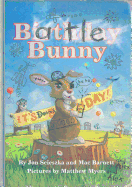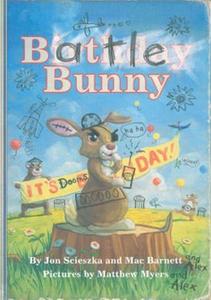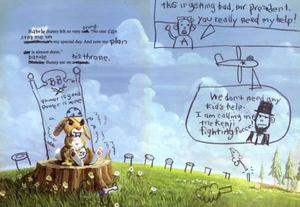

As with all great comedy, timing is everything. The book opens with an idyllic scene of a sweet bunny waking from "a night of pleasant dreams." However, a child (whom we know from "Gran Gran's" inscription is named "Alexander") peers in through the window with a thought balloon that reads, "Uh oh." With a turn of the page, readers see why: the Birthday Bunny transforms into a "Battle Bunny!" sporting a pirate's patch over his left eye and a transmitter; as the rabbit protagonist stretches and stirs, Alex ducks down so only his eyes show.
One of the brilliant things about the book is that the original text is crossed out in pencil in such a way that children can clearly read it, and the ingenious ways in which the recipient of the Birthday Bunny book has amended the words. The contrast between the original story and the rejiggered plot gives the book its humor. The book will be a hit at storytime if you have two readers: one to play sickly-sweet straight man or woman, reciting the original text, while a second reads the doctored-up version in an evil henchman or -woman voice. The art was photographed twice: first as Matthew Myers's rose-colored vision--all sunshine and lollipops--then again after Myers demonizes the rabbit and depicts how the bad bunny wreaked havoc on his environs.
 Authors and artist deconstruct every part of the book, from the half-title and copyright pages to the plug for other books on the back cover. In a standout scene, "Birthday Bunny started on his path, hopping through the trees." The diabolical version: "Battle Bunny started on his Evil Plan, chopping through the trees." Myers depicts the nefarious rabbit wielding a saw and leaving stumps in his path. He overlays cartoon-style panel sequences to chronicle various conflicts, often drawn over bucolic grassy landscapes and clear blue skies, to underscore the irony of the situations.
Authors and artist deconstruct every part of the book, from the half-title and copyright pages to the plug for other books on the back cover. In a standout scene, "Birthday Bunny started on his path, hopping through the trees." The diabolical version: "Battle Bunny started on his Evil Plan, chopping through the trees." Myers depicts the nefarious rabbit wielding a saw and leaving stumps in his path. He overlays cartoon-style panel sequences to chronicle various conflicts, often drawn over bucolic grassy landscapes and clear blue skies, to underscore the irony of the situations.
Scieszka, Barnett and Myers invite children to take an active role in this story and, by extension, all the stories they read--and to think critically about the choices author and artist make. What would readers do differently if they were writing the story? How do text and art work together? How do they play against each other? How can you bring those models into your own writing? Aside from the limitless possibilities to prompt critical thinking, Battle Bunny makes for great entertainment: it's funny, the plot builds, and the protagonist captivates readers' attention. It also begs to be reread and shared. Kids will be eager to compare notes and to relive it with their friends. --Jennifer M. Brown
Shelf Talker: With quick wits and a sharp pencil, the triumphant triumvirate of Sciescka, Barnett and Myers transforms the benign Birthday Bunny into the dastardly Battle Bunny.

